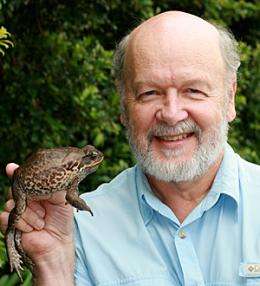Speedy toads advance theory of evolution

(PhysOrg.com) -- Speed and the mating habits of the Australian cane toad are set to expand the theory of evolution according to research published in the Proceedings of the National Academy of Sciences of the USA.
Three Australian biologists, including lead author, Professor Rick Shine, from the University of Sydney's School of Biological Sciences, believe they have identified a new evolutionary process based on their invasive cane toad research.
Professor Shine said the process, which depends on "mating between the quickest" rather than "survival of the fittest", challenges the long-held view that natural selection is the only driving force for evolution.
"For over 150 years, biologists have believed that evolutionary change is caused by only two factors: survival and reproduction," says Shine.
"This new process of evolution does not depend on survival or reproduction.
"In the leading-edge of a spreading population, such as an invasive pest, evolution can happen simply because the fastest individuals always end up at the invasion front.
"Repeated breeding between these fast-dispersing animals causes genes for rapid dispersal to become more and more concentrated in that zone."
Dubbed "spatial sorting", the new evolutionary process explains why the invasion of the cane toad - a highly poisonous tropical frog - has been accelerating through Australia for the last 70 years.
The seven-year study has shown that toads at the invasion front have evolved to move faster than those in areas colonised many years ago. The researchers, including Dr. Greg Brown, also from the School of Biological Sciences, and Dr. Ben Phillips from James Cook University believe this process provides a new explanation for why pest species spread faster over time.
Professor Shine says: "The toad's Australian invasion can be thought of as a race, with only the fastest toads at the frontline. These athletic toads inevitably breed with each other, because all the slow toads have been left behind. Some of their offspring inherit 'speedy' genes from both parents and thus the rate of invasion increases every year."
The process of "spatial sorting" relies on genes for speed accumulating at the increasingly fast-moving frontline. Unlike natural selection - a process first described by Charles Darwin, stating that traits which help an organism survive and reproduce will build up over time - spatial sorting does not require an animal's survival or reproduction to be increased by it being quicker. The new process can only work within the limits set by natural selection, but may be an important cause of evolutionary change in species that are expanding their ranges into new territory.
Provided by University of Sydney

















